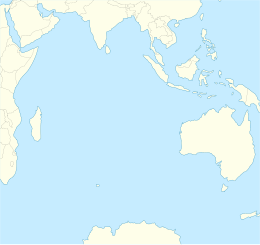Geography of Sri Lanka
|
Native name: Nickname: Pearl of the Indian Ocean |
|
|---|---|
|
Map Sri Lanka
|
|
| Geography | |
| Location | Indian Ocean |
| Coordinates | 7°N 81°E / 7°N 81°E |
| Archipelago | 9 (mkpm0 |
| Area | 65,610 km2 (25,330 sq mi) |
| Area rank | 25th |
| Coastline | 1,340 km (833 mi) |
| Highest elevation | 2,524.13 m (8,281.27 ft) |
| Highest point | Pidurutalagala |
| Administration | |
| Largest settlement | Colombo (pop. 752,993) |
| Demographics | |
| Population | 20,277,597 (2012) |
| Pop. density | 323 /km2 (837 /sq mi) |
| Ethnic groups | Sinhalese - 75%, Sri Lanka Tamils - 11%, Sri Lankan Muslims 9% |
The main island the island nation of Sri Lanka, itself known as Sri Lanka (formerly called Ceylon, Lanka-dvipa, Simhala-dvipa, etc.), is a South Asian island in the Indian Ocean, southeast of the Indian subcontinent, in a strategic location near major Indian Ocean sea lanes.
It has a total area of 65,610 km², with 64,740 km² of land and 870 km² of water. Its coastline is 1,340 km long. Sri Lanka's climate includes tropical monsoons: the northeast monsoon (December to March), and the southwest monsoon (June to October). Its terrain is mostly low, flat to rolling plain, with mountains in the south-central interior. The highest point is Pidurutalagala at 2,524.13 m. Natural resources include limestone, graphite, mineral sands, gems, phosphates, clay, hydropower.
Adam's Bridge, a land connection to the Indian mainland, is now mostly submerged with only a chain of limestone shoals remaining above sea level. According to temple records, this natural causeway was formerly complete, but was breached by a violent storm (probably a cyclone) in 1480. The formation is also known as Rama's Bridge, as according to Hindu mythology, it was constructed during the rule of Lord Rama.
More than 90% of Sri Lanka's surface lies on Precambrian strata, some of it dating back 2 billion years. The granulite facies rocks of the Highland Series (gneisses, sillimanite-graphite gneisses, quartzite, marbles, and some charnokites) make up most of the island and the amphibolite facies gneisses, granites, and granitic gneisses of the Vinjayan Series occur in the eastern and southeastern lowlands. Jurassic sediments are present today in very small areas near the western coast and Miocene limestones underlie the northwestern part of the country and extend south in a relatively narrow belt along the west coast. The metamorphic rock surface was created by the transformation of ancient sediments under intense heat and pressure during mountain-building processes. The theory of plate tectonics suggests that these rocks and related rocks forming most of south India were part of a single southern landmass called Gondwanaland. Beginning about 200 million years ago, forces within the Earth's mantle began to separate the lands of the Southern Hemisphere, and a crustal plate supporting both India and Sri Lanka moved toward the northeast. About 45 million years ago, the Indian plate collided with the Asian landmass, raising the Himalayas in northern India, and continuing to advance slowly to the present time. Sri Lanka does not experience earthquakes or major volcanic events because it rides on the center of the plate.
...
Wikipedia


